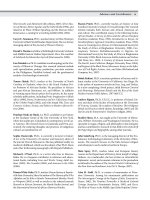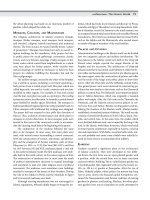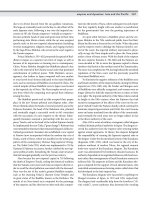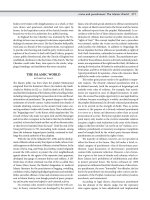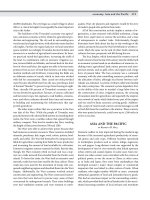Encyclopedia of society and culture in the medieval world (4 volume set) ( facts on file library of world history ) ( PDFDrive ) 627
Bạn đang xem bản rút gọn của tài liệu. Xem và tải ngay bản đầy đủ của tài liệu tại đây (54.31 KB, 1 trang )
600 laws and legal codes: Africa
public policy—a practice common among many of the cultures encompassed by the Mali Empire. Other laws seem to
represent criminal law. For example, anyone who attempted
to murder another person was to be put to death. Mali tended
to use Muslims as judges, and it seems to have had an appeals
system in which people convicted of crimes could petition a
higher authority to void the conviction, but how this worked
has yet to be figured out.
That Mali was a nation of laws seems evident from the
accounts of visitors, mostly Muslims. Ghana in the 1100s and
Mali in the 1300s were praised by visitors for their strong
sense of justice. Travelers on Mali’s roads appear to have been
remarkably safe and secure. Still, the rule of law as embodied
by the imperial government often did not reach throughout
the empire. Especially in remote provinces, the laws that were
enforced tended to be local ones that derived from long-standing regional customs. Villages and towns often were allowed
to make and enforce their own laws, which tended to take
precedence over imperial laws within local communities. The
remarkable safety of travelers noted in the 1300s may have
derived in part from imperial laws that forbade the molesting
of travelers but also from ancient rules of conduct in which
banditry or theft was punishable by exclusion from the community, a fate that may have been worse than death for the
perpetrators, who within their cultural outlook would lose all
sense of personal identity without their places in their communities. Further, people could gain status in a community
by treating strangers well, because in their view the strangers would be obligated to them until the good treatment was
repaid. From this perspective, the Charter of Kurukan Fuga
seems to be in harmony with medieval African customs and
remote from modern controversies.
Written laws and even ones from oral history are hard
to find from medieval Africa. In part this is because in many
cultures laws were memorized by scholars trained for the
purpose, as seems to have been the case in Benin. It is also
partly because written documents may have been lost, as
may be the case for the city-states of East Africa. Archaeologists often seem optimistic that they will someday uncover
legal documents from city-states such as Kilwa or Mogadishu, as they are also hopeful for the Christian kingdoms of
Nubia and the kingdom of Kanem. All were places with literary traditions.
One place where some records survive, although much
revised over many centuries, is Ethiopia. The leaders of Ethiopia took pride in keeping records and even had libraries in
which scribes were perpetually kept busy copying decaying
books in order to maintain a continuous record of history
and thought. Further, the Solomonid Dynasty of Ethiopia
lasted from medieval times to the end of the 1900s, helping to
preserve documents that might otherwise have been lost had
their government been overthrown by invasion.
Legal historians usually refer to two Ethiopian works in
particular: the Kebra Nagast, meaning the “Book of the Glory
of Kings,” and the Fetha Negast (also spelled Fetha Negest),
meaning the “Law of the Kings.” The first contains accounts
of the rulers of Ethiopia, and the second includes a body of
legal precedents. The Fetha Negast was first written as a single
work perhaps in about 1450, though it may have been as early
as the 1200s. It was revised often as times changed, but in
1450 it still represented the legal practices of Ethiopia from
the early medieval era. Its laws drew on the Bible, ancient Roman laws, and traditional Ethiopian customs.
The emperor was embodied in the law as having the final say on all matters of law. The only people allowed to interpret the law and to advise the emperor on legal matters
were scholars trained at the Matshaf Beit, meaning “House
of Books.” The Matshaf Beit served not only as a repository
for writings about the law but as a sort of graduate school of
law, where students would study 30 years to memorize the
empire’s laws and even foreign laws and to understand the
commentaries on the laws.
Medieval Ethiopia had a system of courts and lawyers.
Cases were tried before a judge, called a dania. The danias
were usually debterras, who originally were clerics committed to transcribing documents. They became respected
for their knowledge of literature and law and often became
government officials. Judges were not required to be debterras, so village chiefs or leading community figures, including women, could become judges. Judgments were based on
both imperial and local laws, with local laws usually prevailing over imperial laws. The application of the law required
judges to combine Roman laws, Greek philosophy, traditional
laws, and biblical laws, especially from the Old Testament.
People who lost their cases were able to petition regional or
provincial tribunals and ultimately the emperor, whose decision was final. Enforcement of the law fell to the Ethiopian
nobility and through them to village chiefs.
There were kingdoms in central Africa and southern
Africa, but their laws are little known. Travelers of the late
medieval era reported being able to travel from west Africa
all the way to southeastern Africa through two large kingdoms where the rule of law seemed to prevail. Merchants and
others travelers from outside the kingdoms were required to
pay homage to the kings and pay duties; if they did so, they
had legal protection on the roads of the kingdoms. The merchants would have been traveling to the city-states of East Africa or to Great Zimbabwe, where the nation of Zimbabwe is
today. The city-states were of African origin, and their basic
social structure was local. Yet they were heavily influenced

